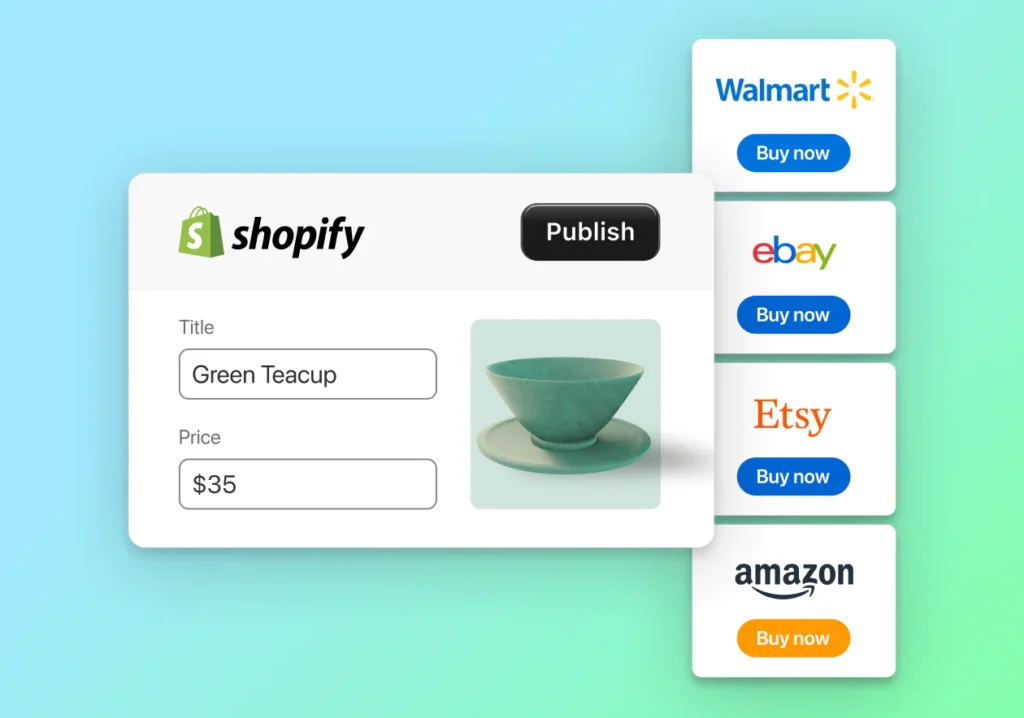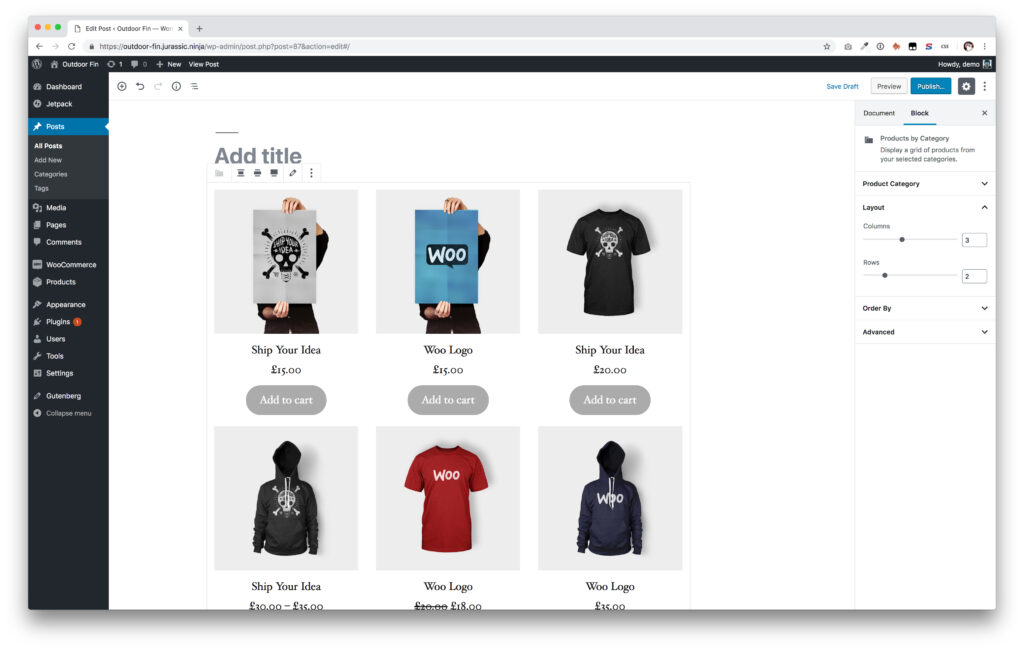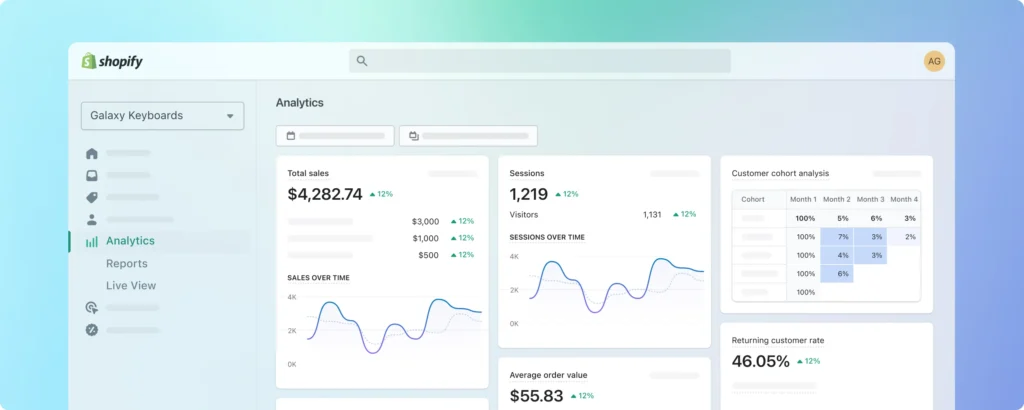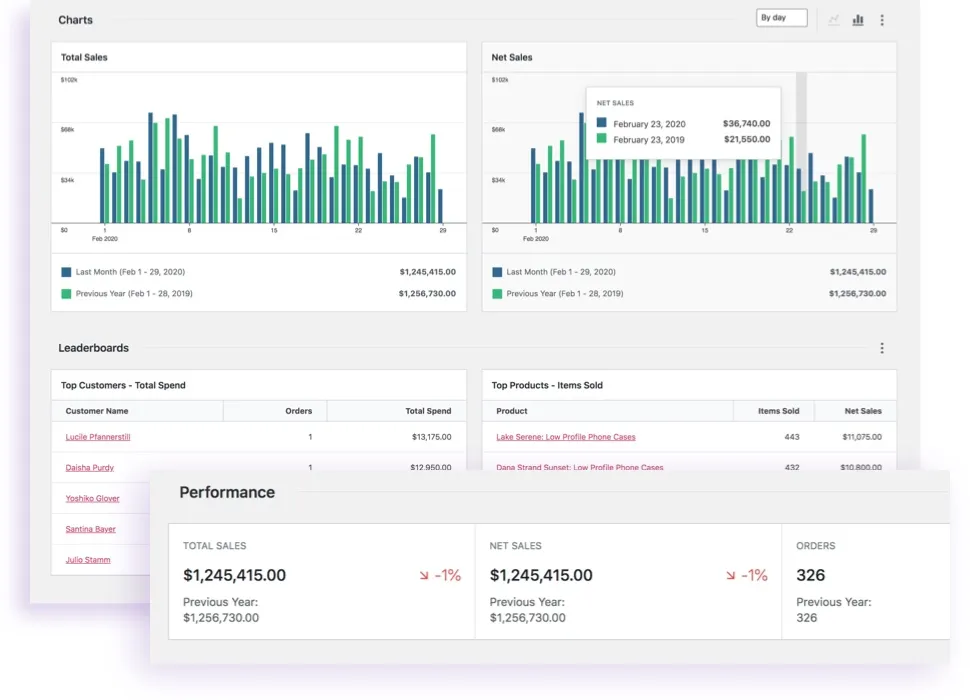Shopify vs WooCommerce – Which is Better & Why? (2023)
In the wild and ever-expanding wilderness of online shopping, two mighty contenders rise above the rest, donning their virtual gloves for an epic battle royale: Shopify and WooCommerce. If you’re donning your entrepreneur hat, ready to set up shop in the digital realm or pondering a platform switcharoo, then this electrifying showdown is your front-row ticket to e-commerce excitement!
Let the Battle Begin: Shopify vs. WooCommerce
Round 1: The Basics

Shopify – The E-commerce Guru
Shopify, the undisputed champion in the world of online retail, is your trusty sidekick, your e-commerce mentor with a splash of pizzazz! Now, what makes Shopify stand out in this corner of the ring, you ask?
- Hosting with a Hint of Magic: Shopify handles all the behind-the-scenes wizardry – hosting, security, and upkeep – so you can sprinkle your attention on your business. Forget about getting tangled in server sorcery, wrestling with software spells, or patching up security enchantments. It’s akin to having a squad of IT wizards in your corner, and the best part? No goblin-sized bill at the end.
- User-Friendly Enchantment: Shopify flaunts an interface so user-friendly, it’s practically enchanted. Setting up your online emporium is a piece of enchanted cake, even if you’re more muggle than tech wizard. Thanks to its whimsical drag-and-drop wand, you can conjure up your dream store, add fantastical products, and tweak its appearance without ever needing a spellbook. It’s like weaving your retail dreams with the wave of a fairy’s wand.
- App Ecosystem: The Shopify App Store is a treasure trove of apps and extensions that can enhance your store’s functionality. From marketing tools to inventory management, there’s an app for almost everything. It’s like having an entire toolbox at your disposal to fine-tune your business operations.
- Customer Support That Never Sleeps: Shopify doesn’t mess around when it comes to helping you out. They’ve got your back 24/7, making sure you’re never wandering in the vast digital desert alone. Whether you’re wrestling with those pesky tech gremlins or need some sage advice on using a fancy feature, assistance is just a mouse-click away. Think of it as having your very own e-commerce genie on call, ready to grant your wishes!
- Professional Design Templates: Shopify provides a wide array of professionally designed themes, both free and paid. These templates are not only visually appealing but also mobile-responsive, ensuring that your store looks fantastic on all devices. It’s like having access to a fashion designer’s collection for your store’s appearance.
- Seamless Payment Processing: With Shopify Payments and support for various other payment gateways, handling transactions is a breeze. It simplifies the checkout process for your customers, reducing cart abandonment rates. It’s like having a cashier who accepts all forms of payment and never makes mistakes.
WooCommerce – The WordPress Wonder
On the other side of the ring, we have WooCommerce, which is often described as the WordPress plugin that morphs your ordinary website into a robust online store. It’s like turning your family-run bakery into a bustling marketplace. Here’s what makes WooCommerce stand out in this round:
- Open-Source Odyssey: WooCommerce dances to its open-source rhythm, bringing you a double scoop of goodness – it’s both free and as flexible as a yoga instructor at a contortionist convention. You’re the maestro here, crafting your online masterpiece on a canvas that’s as blank as a yet-to-be-discovered planet.
- WordPress Wonderland: WooCommerce and WordPress are like the dynamic duo of the web. It’s like having Batman and Robin working together, but in this case, Batman is your content marketing and SEO prowess, and Robin is your trusty e-commerce store. Two birds, one stone, all under one virtual roof.
- Infinite Customization: With WooCommerce, your store is the proverbial snowflake in a digital avalanche. You’re not just picking themes and plugins; you’re creating a unique digital universe. Whether you want to sprinkle some magic with product filters, design a checkout process that’s smoother than jazz, or summon third-party services, WooCommerce says, “Your wish is my command!”
- Scalability on Your Terms: Think of WooCommerce as a magical plant. You can start with a tiny seed and watch it grow into a magnificent tree, all at your own pace. Ideal for startups and small businesses, it’s like nurturing your digital baby as it blossoms into an e-commerce empire.
- Ecosystem Extravaganza: Enter the mystical realm of the WooCommerce ecosystem. It’s a bustling marketplace where developers, designers, and enthusiasts gather like digital nomads around a virtual campfire. Here, you’ll find tutorials that are juicier than ghost stories, forums buzzing with more activity than a beehive, and extensions crafted with more care than grandma’s secret recipes.
- Unlimited Ownership: Unlike those platforms where you’re just a tenant, WooCommerce gifts you the keys to your digital kingdom. You’re the master of your domain, choosing your hosting provider, guarding your site like a fortress, and steering your data ship wherever you please. It’s like owning prime real estate in the metaverse – complete control, zero landlord.
The Verdict: So, in this clash of titans, the question is: Are you looking for the simplicity and hand-holding of Shopify, where you can focus solely on your business, or do you embrace the freedom and endless possibilities offered by WooCommerce, where your store can be as unique as your fingerprint? The choice is yours, my entrepreneurial friend.
Round 2: Cost and Pricing

Shopify – The Pay-to-Play Model
Shopify’s pricing structure may look as straightforward as a symmetrical snowflake, but let’s unravel it with a curious twist. Imagine the “Basic” plan at $29/month as your ticket to an exclusive club, but instead of dancing under neon lights, you’re crafting your digital storefront. This entry fee covers the essentials—hosting, security, and the ever-helpful customer support crew.
Now, here’s the plot twist: If you dare to tread the path of third-party payment gateways instead of Shopify’s in-house charmer, Shopify Payments, prepare for a little game of “fees and fines.” These fees can multiply faster than rabbits at a magician’s convention, especially if you’re dealing with a bustling transaction carnival. It’s akin to enjoying a sumptuous meal at a restaurant only to be hit with an extra charge for swiping plastic instead of flaunting cash. To evade this unexpected twist, you might find yourself upgrading to the pricier plans—cue the Shopify Advanced and Shopify Plus, the real MVPs.
But don’t despair, my e-commerce adventurer, for Shopify’s pricing extravaganza grants you an all-access pass to its app store wonderland. Picture this as a shopping spree in a digital bazaar, where you can discover an array of tools and accessories to spruce up your store’s charisma. Just remember to keep a wise eye on your budget, as not all treasures here come free. It’s like wandering through a mall of endless possibilities, each enticing you to level up your online retail game.
WooCommerce – The Budget-Friendly Maverick
WooCommerce, on the other hand, has a different approach to cost. The base plugin itself is free, which can be a breath of fresh air for budget-conscious entrepreneurs. It’s like receiving a versatile DIY toolkit without spending a dime. However, don’t celebrate just yet, because there are other expenses to consider.
To get your WooCommerce store up and running, you’ll need to invest in web hosting and a domain name. These are ongoing costs that can vary depending on your chosen hosting provider and domain registrar. It’s akin to renting a space for your brick-and-mortar store.
Additionally, while WooCommerce offers a plethora of free plugins and themes, you might find yourself tempted by premium extensions or themes that provide advanced features and customization options. These can range in price, and it’s easy to go down a rabbit hole of “just one more plugin.” It’s similar to buying tools for your toolkit, but some come with a price tag.
So, when it comes to cost and pricing, it’s not just about comparing monthly subscription fees. It’s about evaluating the holistic financial picture. Are you willing to pay a bit more upfront for Shopify’s convenience and potentially avoid transaction fees, or do you prefer the freedom and flexibility of WooCommerce, even if it means managing various costs independently?
Ultimately, your choice will depend on your budget, business model, and long-term vision. In this round, it’s not just about who’s cheaper but who aligns better with your financial strategy. Remember, the goal is not just to save money but to invest it wisely in building a successful online store.
The Verdict: If you’re counting every penny, WooCommerce takes the win. But if you value convenience and don’t mind paying a bit extra, Shopify has your back.
Round 3: Ease of Use

Shopify – The User-Friendly King
Shopify’s reputation for being user-friendly is well-earned. It’s like having a personal assistant who guides you through the process of setting up your online store. Here’s why Shopify takes the crown in this category:
- Intuitive Interface: Shopify prides itself on having one of the most user-friendly interfaces in the e-commerce world. Its dashboard is designed with simplicity in mind, making it easy for even the least tech-savvy individuals to navigate. Setting up your store, adding products, and managing orders is as straightforward as a few clicks.
- Drag-and-Drop Builder: Shopify offers a visual, drag-and-drop store builder that allows you to customize your website’s look and feel without any coding knowledge. This feature empowers you to create a professional-looking online store with ease.
- Abundance of Templates: Shopify provides a vast collection of professionally designed templates. These templates are not only aesthetically pleasing but also highly functional, catering to various industries and niches. You can choose a template that aligns perfectly with your brand’s personality.
- App Store Ecosystem: Shopify boasts an extensive app store, offering a wide range of apps and plugins to enhance your store’s capabilities. Whether you need tools for marketing, inventory management, or customer support, there’s likely an app that can help streamline your operations.
- Excellent Customer Support: Shopify’s customer support is top-notch. They offer 24/7 assistance, ensuring that you can get help whenever you encounter an issue. Whether it’s a technical glitch or a simple query about using a feature, their support team is there to assist you promptly.
- User Training and Resources: For those new to e-commerce, Shopify provides comprehensive training materials, including video tutorials and guides. They also host webinars and offer online courses to help you get the most out of your Shopify store. This commitment to user education underscores their dedication to being user-friendly.
WooCommerce – The Learning Curve
WooCommerce, being a plugin for WordPress, has a slightly steeper learning curve. It’s akin to starting a DIY home improvement project. Here’s what you can expect:
- WordPress Foundation: WooCommerce is built on top of WordPress, the world’s most popular content management system. This means that to effectively use WooCommerce, you’ll first need to have a basic understanding of how WordPress works. If you’re already familiar with WordPress, this is a bonus; if not, it might add a bit more to your learning curve.
- Customization Opportunities: While WooCommerce’s flexibility allows for extensive customization, this can also make it a bit overwhelming for beginners. You’ll need to learn how to navigate the WordPress admin panel, install plugins, and manage themes to tailor your online store to your liking.
- Plugin Management: WooCommerce relies heavily on plugins to add functionality to your store. You’ll need to understand which plugins are essential for your business and how to install, configure, and update them. Some plugins may require additional setup and integration, adding to the learning curve.
- Product Management: Managing products in WooCommerce involves various settings and options, from product types (simple, variable, downloadable) to inventory management, shipping, and pricing. You’ll need to become proficient in using these features to efficiently run your store.
- Payment and Shipping: WooCommerce offers a range of payment and shipping options, but setting them up correctly can be complex. You’ll need to understand payment gateways, shipping zones, and the various settings related to taxes and shipping costs.
- Troubleshooting and Maintenance: Like any e-commerce platform, WooCommerce may encounter occasional issues or conflicts between plugins and themes. Being able to troubleshoot and resolve these problems is a valuable skill, and it may require research, online resources, or even seeking help from the WooCommerce community.
In this round, the choice boils down to your comfort level and goals. Shopify is the clear winner if you want a hassle-free, user-friendly experience. It’s perfect for those who value simplicity and want to get their store up and running quickly. You don’t need to worry about the technical intricacies; Shopify takes care of that for you.
On the other hand, if you’re a hands-on entrepreneur who enjoys the process of building and customizing your online store, WooCommerce offers the flexibility and control you crave. It’s like embarking on a DIY home improvement project; it may require more effort and expertise, but the end result can be uniquely satisfying.
The Verdict: Shopify wins this round if you’re aiming for simplicity. But if you’re a hands-on DIY enthusiast, WooCommerce might be your jam.
Round 4: Design and Customization

Shopify – The Designer Boutique
Shopify, often praised for its simplicity and user-friendliness, offers a wide selection of professionally designed themes. These themes cover a range of industries and styles, from fashion and electronics to niche markets like pet accessories or retro gaming.
1. User-Friendly Customization:
Shopify’s theme editor is a drag-and-drop marvel. Even if you’re not a tech wizard, you can effortlessly customize your store’s appearance. Want to change the color scheme, rearrange product listings, or tweak font styles? It’s as easy as pie. No coding knowledge required!
2. Diverse Theme Options:
The Shopify Theme Store boasts a vast collection of both free and premium themes. Free themes provide a solid foundation, while premium options offer advanced features and unique designs. With this variety, you can find a theme that aligns perfectly with your brand identity.
3. App Integration:
If the theme’s built-in customization options don’t cover your specific needs, Shopify’s extensive app store comes to the rescue. You can find apps for everything from adding a live chat feature to implementing complex product customization.
4. Mobile Responsiveness:
In the era of mobile shopping, Shopify themes are optimized for mobile devices, ensuring your store looks fantastic and functions flawlessly on smartphones and tablets. This is a crucial factor since Google now prioritizes mobile-friendly sites in its search rankings.
WooCommerce – The Tailor-Made Suit
WooCommerce, as a plugin for WordPress, offers an entirely different approach to customization. It’s like having a tailor create a suit that hugs every curve of your vision. Here’s what makes WooCommerce stand out in terms of design and customization:
1. Complete Creative Control:
With WooCommerce, your design canvas is virtually limitless. WordPress, as the foundation, provides an extensive library of themes, including both free and premium options. These themes cater to various design aesthetics and can be further customized to your heart’s content.
2. Plugin Power:
The real magic of WooCommerce’s customization lies in its compatibility with a vast array of WordPress plugins. Need a unique product configurator or a personalized recommendation engine? There’s likely a plugin for that. WooCommerce’s flexibility allows you to sculpt your store to perfection, even if it means crafting custom solutions.
3. Brand Consistency:
For businesses that already have a WordPress website, WooCommerce seamlessly integrates with your existing design, maintaining brand consistency. Your online store becomes a natural extension of your website, providing a unified user experience.
4. Developer-Friendly:
WooCommerce appeals to those who have a bit of technical know-how or have a developer on hand. While it offers robust customization options, some advanced changes may require coding skills. However, with countless resources available online, you can find guidance for nearly any customization task.
In the world of Design and Customization, Shopify shines as the go-to option for entrepreneurs who crave a visually appealing store without the fuss. It’s like walking into a designer boutique and picking out the latest fashion trends effortlessly. If you value simplicity and style, Shopify won’t disappoint.
On the other hand, WooCommerce caters to the adventurous spirits who yearn for complete control over their online store’s appearance. It’s the tailor-made suit of e-commerce, allowing you to craft a unique identity for your brand. If you’re not afraid to roll up your sleeves and get creative, WooCommerce welcomes you with open arms.
The Verdict: Shopify is for those who want a stunning store without breaking a sweat, while WooCommerce is for those with a unique vision and the patience to see it through.
Round 5: Scalability and Growth
Shopify – The Sky’s the Limit
Shopify is renowned for its scalability. Whether you’re starting with a handful of products or have ambitions to build an e-commerce empire, Shopify is equipped to support your growth. Here’s why:
- Reliable Infrastructure: Shopify is a hosted platform, which means it takes care of server management and performance optimization. This allows you to focus on growing your business rather than worrying about technicalities.
- App Ecosystem: Shopify boasts a vast app store with a myriad of apps and integrations. These apps can help you add new features, optimize your store, and enhance your customer experience as your business expands.
- Scalable Pricing: Shopify’s pricing plans are designed to accommodate businesses of all sizes. As your revenue and customer base grow, you can easily upgrade your plan to access more advanced features and capabilities.
- Global Reach: Shopify offers multilingual and multicurrency support, enabling you to reach a global audience. It also provides localized payment options, making it easier for international customers to shop on your site.
- Enterprise Solutions: For large-scale enterprises, Shopify Plus offers a dedicated platform with advanced features and customization options. It’s the key to unlocking the full potential of your e-commerce business.
WooCommerce – The Infinite Possibilities
WooCommerce’s scalability is a bit different. It offers incredible flexibility, but the extent of your scalability depends on several factors:
- Hosting: Since WooCommerce is a self-hosted solution, the quality of your hosting service can significantly impact your store’s performance and scalability. Choosing a reliable and scalable hosting provider is crucial.
- Technical Expertise: Scaling a WooCommerce store may require some technical know-how, especially when optimizing for high traffic and complex functionality. This could involve tasks like optimizing database queries and implementing caching mechanisms.
- Plugins and Themes: WooCommerce’s library of plugins and themes can be a boon for customization and expansion. However, be cautious when adding too many, as poorly coded or conflicting plugins can affect your site’s performance.
- Performance Optimization: To maintain fast load times and a smooth user experience as your store grows, you may need to invest in performance optimization strategies, such as content delivery networks (CDNs) and server upgrades.
- Developer Assistance: For businesses with ambitious growth plans, working with experienced developers can be invaluable. They can help you fine-tune your store’s performance and tailor it to your specific needs.
In essence, WooCommerce’s scalability is limited only by your technical resources and expertise. While it requires more hands-on management, it offers unparalleled freedom and control over your online store’s growth trajectory.
The Verdict: If you’re gearing up for massive expansion and want a platform that can effortlessly handle it, Shopify is the clear winner. However, if you’re willing to invest in technical expertise and enjoy the freedom to build a truly unique online store, WooCommerce can be your ultimate growth companion. Choose wisely, for your decision will shape the future of your e-commerce venture..
Round 6: Payment Options
Shopify – The Payment Gateway Buffet
Imagine walking into an all-you-can-eat buffet, but instead of food, it’s a vast array of payment gateways. That’s the experience Shopify offers. With its proprietary payment gateway called Shopify Payments, you have a robust, secure, and seamless option right out of the box. It’s like having the buffet’s signature dish – fresh, convenient, and satisfying.
However, if you prefer a specific payment provider, Shopify plays nice with a wide variety of them, from PayPal to Stripe and beyond. But here’s the catch: when you use third-party gateways, Shopify levies a transaction fee, unless you’re on the Shopify Plus plan. It’s akin to enjoying a meal at the buffet but paying a little extra when you order off the menu.
Shopify Payments does have its perks, though. It integrates seamlessly with your store, offering a unified checkout experience, reducing cart abandonment rates, and potentially increasing conversion rates. Plus, it covers all the bases, from credit cards to Apple Pay, giving customers multiple ways to pay for their purchases. It’s like having a versatile payment Swiss Army knife in your e-commerce toolkit.
WooCommerce – The Freedom of Choice
WooCommerce is the platform that puts you in the driver’s seat when it comes to payment options. It’s like owning your restaurant and deciding exactly which payment gateways you want to offer to your customers.
With WooCommerce, you have the freedom to choose from a wide range of payment gateways without worrying about additional transaction fees imposed by the platform itself. Whether you want to accept credit cards, PayPal, or niche payment methods tailored to your target audience, it’s all within your control. It’s like curating your menu to cater to the tastes of your specific clientele.
This flexibility is especially valuable for businesses that operate internationally or have unique payment requirements. You’re not bound by the platform’s preferences; you can cater to your customers’ preferences. It’s akin to being a chef who tailors each dish to suit the individual diner.
However, this freedom comes with a responsibility – you’ll need to manage and maintain these payment gateways yourself. While it grants you unparalleled control, it also means you’re in charge of ensuring security, compliance, and seamless integration. It’s like being the head chef and the restaurant manager rolled into one – more work, but more control.
The Verdict: Shopify has a buffet of options, but you might pay a bit extra for your favorite dishes. WooCommerce gives you the freedom to create your menu. So, whether you’re looking for a streamlined checkout experience or crave the liberty to choose, the payment options in this round ultimately depend on your taste and business strategy.
Round 7: SEO and Blogging
Shopify – The SEO Prodigy
Shopify has earned its reputation as an SEO prodigy in the world of e-commerce platforms. It comes equipped with a range of built-in SEO features that make it a strong contender in the SEO game.
- SEO-Friendly URL Structure: Shopify automatically generates clean and SEO-friendly URLs for your product pages, collections, and blog posts. This not only enhances user experience but also helps search engines understand your content better.
- Mobile Responsiveness: Mobile-friendliness is a crucial factor in SEO ranking. Shopify’s themes are designed to be responsive, ensuring that your online store looks great and functions seamlessly on various devices, from smartphones to tablets.
- Fast Loading Speed: Shopify takes care of hosting and server optimization, which means your site is likely to have fast loading speeds. Page speed is a known ranking factor in search engines, contributing to a better user experience and improved SEO performance.
- Meta Tags and Descriptions: You have full control over meta titles and descriptions for product pages and blog posts. This allows you to optimize your content for specific keywords and improve click-through rates from search engine results pages (SERPs).
- Structured Data: Shopify includes structured data markup, helping search engines understand the content and context of your products. This can lead to rich snippets in search results, increasing visibility and click-through rates.
- Built-In Blogging Platform: Shopify offers a user-friendly blogging platform, allowing you to create and publish content easily. Blogging not only engages your audience but also provides fresh, relevant content that can boost your SEO efforts.
WooCommerce – The SEO Ninja
WooCommerce, as part of the WordPress ecosystem, is often hailed as an SEO ninja. It provides a level of control and flexibility that can give your SEO efforts an edge.
- WordPress SEO Plugins: WooCommerce seamlessly integrates with powerful SEO plugins like Yoast SEO and All in One SEO Pack, which offer advanced SEO optimization features. These plugins enable you to fine-tune your SEO settings, including meta tags, XML sitemaps, and schema markup.
- Content Management: WordPress, combined with WooCommerce, excels as a content management system (CMS). You can create SEO-rich blog posts, landing pages, and product descriptions, all optimized for your target keywords.
- URL Customization: With WordPress, you can fully customize your URL structure, allowing for strategic keyword placement. This flexibility ensures that your URLs align with your SEO strategy.
- Canonical URLs and Redirects: Managing canonical URLs and redirects is more straightforward in WooCommerce, which can help prevent duplicate content issues and preserve SEO equity.
- SEO-Friendly Themes: WordPress offers a plethora of SEO-optimized themes, ensuring your site’s design not only looks good but also adheres to best practices for SEO.
- User-Generated Content: WordPress and WooCommerce make it easy for customers to leave reviews and comments. User-generated content can boost SEO by providing fresh, unique content and improving engagement.
The Verdict: When it comes to SEO and Blogging, Shopify offers a solid foundation with its built-in SEO features and user-friendly blogging platform. It’s an excellent choice for those who want to dive into e-commerce without extensive SEO expertise.
WooCommerce, on the other hand, is the preferred platform for SEO enthusiasts and those who prioritize complete control over their SEO strategy. With WordPress and its powerful SEO plugins, you can fine-tune every aspect of your site’s SEO, making it a formidable force in the search engine rankings.
In the end, the choice between Shopify and WooCommerce in this round depends on your SEO goals and your comfort level with SEO practices.
Round 8: Support and Community
Shopify – The Support Maestro
Shopify boasts a 24/7 customer support system that can be a genuine lifesaver when you’re facing technical hiccups or need quick answers to your burning questions. Imagine having a friendly customer service representative available at all hours, ready to help you navigate the e-commerce maze. Whether it’s a payment issue, a theme customization snag, or simply a query about setting up a discount code, Shopify’s support is there to lend a helping hand.
But it doesn’t stop there. Shopify has cultivated a thriving ecosystem of experts, known as the Shopify Experts, who can assist you with anything from store setup to marketing strategies. These professionals are like your personal e-commerce consultants, ensuring you make the most of your online business.
Furthermore, Shopify’s community is robust and active. With countless forums, Facebook groups, and subreddits dedicated to Shopify, you’ll never feel alone on your journey. Whether you’re a rookie or a seasoned pro, you can tap into the collective wisdom of the Shopify community to find solutions, share insights, and stay up-to-date with the latest e-commerce trends.
WooCommerce – The DIY Spirit
WooCommerce, in contrast, follows a different path when it comes to support. It doesn’t offer official customer support in the same way Shopify does. Instead, it places a strong emphasis on the DIY (Do It Yourself) ethos. This means that when you encounter an issue or have a question, you’re encouraged to roll up your sleeves and explore the vast world of WooCommerce resources.
The WooCommerce community, while not as centralized as Shopify’s support system, is a bustling hive of activity. You’ll find forums, blogs, YouTube channels, and tutorials created by passionate WooCommerce enthusiasts who are eager to share their knowledge. It’s like joining a club of fellow adventurers, where everyone has their unique tips and tricks to offer.
The freedom to troubleshoot and solve problems on your own can be both empowering and educational. WooCommerce’s DIY approach encourages you to become an e-commerce wizard, capable of tackling challenges head-on. While it may take a bit more effort initially, the sense of accomplishment and self-sufficiency that comes with it can be incredibly rewarding.
The Verdict: Shopify is the clear winner if you prefer the safety net of professional support. With 24/7 assistance and a vast pool of experts, you’ll always have someone to turn to when you need help. It’s like having a trusty mentor by your side, ready to guide you through the e-commerce wilderness.
On the other hand, WooCommerce empowers you to become self-reliant. It’s an excellent choice if you enjoy solving problems independently and relish the freedom to experiment. The WooCommerce community serves as your virtual campfire, where you gather with fellow explorers, sharing stories, and finding your way together.
In this round, it’s not just about convenience or expertise; it’s about your entrepreneurial spirit and how you prefer to navigate the challenges of e-commerce. The choice is yours – the supportive embrace of Shopify or the adventurous journey of WooCommerce.
Conclusion: The Final Bell
So, who emerges victorious in this epic showdown between Shopify and WooCommerce? It ultimately boils down to your unique needs and preferences.
Shopify is like the reliable, all-inclusive vacation package. It’s hassle-free, offers top-notch support, and suits those who want a user-friendly experience with all the bells and whistles.
WooCommerce, on the other hand, is the rugged explorer’s choice. It’s budget-friendly, highly customizable, and perfect for those who crave complete control over their online store.
The ring is yours, dear entrepreneur. Will you choose the glitz and glam of Shopify, or will you embrace the wild, customizable world of WooCommerce? The decision is yours.
FAQ
Can I switch from Shopify to WooCommerce (or vice versa)?
Absolutely! You can migrate your store from one platform to another, but it may involve some manual work or hiring a professional to assist with the transition. Both platforms have tools and services available to help with the process.
Which platform is better for dropshipping?
Both Shopify and WooCommerce are suitable for dropshipping businesses. Shopify’s extensive app store includes numerous dropshipping apps, while WooCommerce’s flexibility allows you to set up a dropshipping store with ease.
Are there any hidden fees with Shopify or WooCommerce?
While Shopify has straightforward pricing, keep in mind that using third-party payment gateways on Shopify may incur additional transaction fees. With WooCommerce, you’ll need to consider hosting and potential costs associated with premium plugins or themes.
Can I use WooCommerce without a WordPress website?
No, WooCommerce is a plugin designed specifically for WordPress websites. If you don’t have a WordPress site, you’ll need to set one up to use WooCommerce effectively.
Which platform is better for SEO?
Both Shopify and WooCommerce can excel in SEO when configured correctly. However, WooCommerce, being part of WordPress, offers more extensive SEO capabilities and flexibility, making it a strong choice for those prioritizing search engine optimization.
Can I sell digital products on both platforms?
Yes, both Shopify and WooCommerce support the sale of digital products. You can easily set up and sell digital downloads like e-books, music, software, and more on either platform.
Do I need technical expertise to use WooCommerce?
While WooCommerce is more customizable, it may require some technical know-how to set up and manage, especially if you plan to make extensive customizations. However, there are many tutorials and resources available to help you along the way.
Can I use my own domain name with both platforms?
Yes, you can use your own domain name with both Shopify and WooCommerce. They provide options for domain registration or linking to an existing domain.
Which platform has better mobile responsiveness?
Both Shopify and WooCommerce offer mobile-responsive themes and designs. Your site’s mobile-friendliness will largely depend on the theme you choose and how you customize it.
Can I sell on social media with Shopify and WooCommerce?
Yes, both platforms offer integrations and tools to sell products on social media platforms like Facebook and Instagram. You can expand your reach and reach potential customers on these popular social networks.

Since 2019, Sabrina has been sharing her expertise as the author of three online courses, making photography and videography accessible to all, regardless of age or talent. Her blog, moonlight3d, serves as a hub for connecting with her audience, offering valuable tips on software, videography, and personal experiences. Feel free to reach out to Sabrina for insights and guidance on your creative journey through photography and videography.
